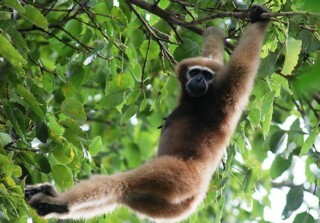Where’s my tail?
Liam Shaw
At some point in the past, humans and other apes lost their tails. Research recently published in Nature proposes a mechanism to explain how. We still have many of the necessary genes, but a single insertion of a small genetic sequence at a new location may have inadvertently turned off tail development.
The genetic sequence is known as an Alu element. They are genomic minnows: only around three hundred base-pairs of DNA compared to more than ten thousand base-pairs for an average gene. Their name comes from Arthrobacter luteus, a bacterium first found in sewage from a Japanese brewery in 1969. A paper published in 1976 showed that A. luteus had an enzyme that chopped up DNA whenever it found the short sequence AGCT.
Such DNA-chopping enzymes had originally been identified because of their role in defending bacteria against viruses. They protect the cell by chopping up viral DNA at highly specific target sequences. That specificity was a molecular biologist’s dream: you could manipulate DNA with them, chopping genomes apart in predictable ways to create maps of the ways the fragments stuck together. (The co-discoverer of the Alu enzyme still maintains a database of thousands of other chopping enzymes and their targets.)
One of the early findings was that the human genome contained bundles of repeated sequence. In 1980, researchers using the Alu enzyme reported that most of these stretches contained AGCT, and all seemed to have come from a single ancestor. They speculated that these ‘Alu elements’ probably had an important function.
It turned out, however, that the abundance of Alu elements is due not to their usefulness but to their capacity for self-promotion. We often talk of DNA as encoding instructions. A better analogy might be that a human genome is an absurdist play in which the characters have to copy out the script for the following evening’s performance. An Alu element would then be a short stage direction: ‘Alu enters, grabs the new script, turns to a random page and copies this sentence in as an additional stage direction.’
As the play is performed again and again, successive scripts contain more and more instances of the Alu stage direction that does nothing but copy itself: mostly a minor annoyance, but occasionally disruptive, throwing an entire scene off-balance. According to current estimates, about 10 per cent of our genome consists of Alu elements. The figure isn’t higher only because Alu elements don’t in fact paste themselves in all that often – there’s one new instance roughly every two hundred births – but when it happens, they’re almost impossible to shift.
It’s thought that the million or so Alu elements in our genome all descend from a rogue piece of RNA in a primate ancestor. That RNA had another role but experienced a fortuitous deletion, turning it into a self-proliferating machine, known as a retrotransposon, that could copy and paste itself back in as DNA somewhere else. The proliferation of Alu elements over 65 million years of primate evolution provides a fossil record of our inheritance.
Alu insertions can sometimes be consequential. A gene called TBXT is key for tail development. The recent Nature paper estimates that an Alu insertion in a hominoid ancestor’s TBXT about 25 million years ago effectively turned off the cascade of information that leads to the formation of a tail. In a genetic mechanism known as alternative splicing, the inserted Alu element would have combined with another Alu element that was already there, leading to a deletion in the translated version of TBXT and disrupting tail development. Other genetic mechanisms would almost certainly have come into play afterwards to stabilise it.
So much for the how. What about the why? Biologists have previously told just-so stories about the reasons apes lost their tails. Comparisons to other primates are instructive: mandrills and macaques lost their tails independently. It’s plausible that the cost of developing a tail was too high for primates that don’t spend a lot of time living in trees.
If tail loss had a selective advantage then it was probably inevitable, whether caused by the Alu element or not. It’s also been speculated, however, that tail loss in apes may be an instance of ‘genetic drift’. Neutral changes, especially in small populations, can sometimes stick around because of chance. That must be the case for at least some of the Alu elements we carry. If it were true in this case, a rogue Alu element that copied itself in a single primate ancestor might have robbed all of us of our tails for no good reason – which seems a shame.
